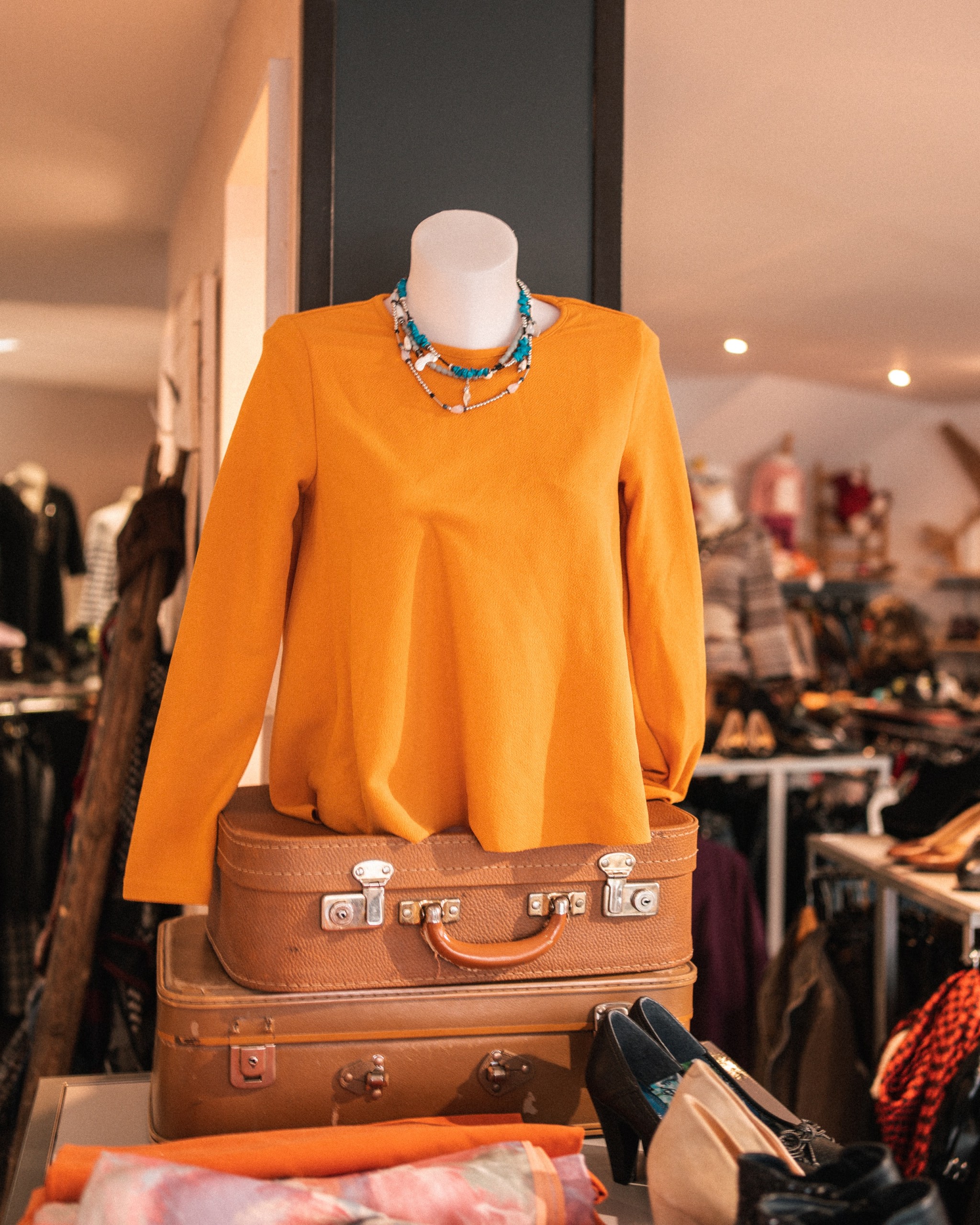The world of fashion is undergoing a remarkable transformation, driven by a collective desire for sustainability and a shift in consumer consciousness. As part of creating a more sustainable industry, second hand fashion is becoming a key part of the supply chain. But will this trend continue, and is second hand fashion a realistic solution to sustainability? In this blog, we delve into the increasing role that reselling and second hand fashion are playing in sustainability, whether consumers can be convinced to choose second hand fashion as a first choice, and if second hand fashion really is a sustainable solution.
The growth of second hand fashion
The world of fashion is undergoing a transformation as the rise of second-hand clothing gains momentum. In the face of a persistent cost-of-living crisis, consumers are increasingly turning to second-hand fashion as a practical and sustainable solution. Pre-loved clothing purchased has surged against a backdrop of economic instability in the UK since 2021.
Vinted, Europe’s largest online marketplace for used clothing, is at the forefront of this movement, challenging the traditional fashion industry. As Vinted considers a secondary share sale worth over €200 million, it’s evident that sustainable fashion is not just a trend; it’s a booming industry.
Vinted’s remarkable journey from a Lithuanian startup to a brand valued at €3.5 billion in May 2021 is a testament to the growing appeal of sustainable fashion. The platform allows people to buy and sell second-hand clothes, reflecting a global trend that is expected to nearly double the $177 billion global second-hand apparel market by 2027. But it’s not only Vinted. Other platforms such as Depop, eBay and vintage or charity shop retail options are also driving increased purchasing of second hand fashion.
How can second hand fashion benefit the environment?
Second-hand fashion benefits the environment in multiple ways. It reduces textile waste, decreases energy and resource consumption, cuts down on carbon emissions, and discourages harmful chemical pollution associated with new clothing production. By promoting a circular economy, second-hand fashion encourages sustainable consumption, preserves natural resources, and supports ethical and sustainable practices.
Overall, choosing second-hand clothing is an option that has the potential to minimise the impact of the fashion industry on the environment. But it’s not enough to simply buy second hand in addition to still buying new. In order to have this impact, consumers must be persuaded to buy second hand fashion items first, before looking at new fashion items.
So, how can consumers be persuaded to buy more second hand fashion?
From 2000 to 2015, global clothing production saw a significant increase, nearly doubling during this period. Clothing items were used 36% less before they were discarded. In 2015, a staggering 6.4 million tons of clothing were consumed in Europe. Notably, the UK stands out with its higher per capita clothing purchases compared to the European average. This trend is mirrored in France, Germany, and Italy, all of which have recorded elevated levels of clothing ending up in residual waste.
As you can see from the above, there is no shortage of clothing items. But how can consumers be persuaded to view second hand as a first option?
There are a number of ways consumers can be encouraged to prioritise second-hand fashion over buying brand new, including:
Promote Ethical and Sustainable Practices:
Brands can highlight their own sustainable and ethical practices, demonstrating that they prioritise these values in both their new and second-hand or resell ranges. Transparent information about the sourcing, production, and labour practices associated with second-hand items can help build trust with consumers.
Collaborations and Partnerships:
Second hand brands or resellers can collaborate with influencers, celebrities, and fashion bloggers who already embrace second-hand fashion. Their endorsements and personal stories can have a significant impact on their followers, inspiring them to consider second-hand options.
Focus on quality and range:
To make second hand fashion a viable choice, brands should curate a selection of second-hand items that align with current fashion trends, as well as being high quality. Providing stylish, well maintained options can dispel the myth that second-hand clothing is outdated or of lesser quality, making it more likely that consumers will buy second hand items.
Community Building:
Social media and apps make it easier for brands to create a genuine sense of community surrounding second-hand fashion. This community aspect can foster a sense of belonging and encourage more people to adopt second-hand fashion.
Positive Environmental Messaging:
Branding is important, and fashion brands must consistently emphasise the positive environmental impact of choosing second-hand fashion. By showcasing the reduction in waste and carbon emissions associated with second-hand shopping, brands can motivate consumers to make more sustainable choices.
Support Circular Fashion Initiatives:
Brands can participate in or launch circular fashion programs, such as clothing recycling, upcycling, and repair services. These initiatives demonstrate a commitment to extending the lifespan of clothing and minimising waste.
The role of major fashion brands
Vinted faces competition not only from similar platforms like UK-based Depop but also from established fashion giants. Companies like H&M and ASOS have recognised the growing demand for second-hand fashion and are eager to tap into this growing market; both as a way to support sustainability, but also as a powerful marketing tool. They’re introducing initiatives to encourage consumers to embrace pre-owned clothing.
These initiatives include launching second-hand fashion collections, investing in innovative marketing campaigns to promote vintage or second hand fashion, using brand ambassadors across platforms such as TikTok and Instagram, and actively promoting sustainability through garment collection and recycling initiatives. Partnerships and collaborations are also key, with fashion brands collaborating with well-known designers and influencers who are already knows to be advocates of sustainable fashion.
The competition between Vinted and established fashion giants potentially represents a positive trend for the fashion industry. It signifies a collective recognition of the importance of sustainable fashion and a growing shift in consumer preferences. It’s important for these companies to continue to invest in second-hand and sustainable fashion initiatives to drive the movement towards more sustainable clothing choices.
The dark side of second hand fashion
It’s important to note that while second hand fashion offers positive progress in making fashion more sustainable, it’s not, and shouldn’t be considered the silver bullet for solving the problems associated with today’s fast fashion industry.
Just with new fashion items, there are also a number of issues with second hand fashion reselling. These include:
- The Decline in Fabric Quality and Ethical Production: Modern clothing is often manufactured from subpar materials, often by underpaid workers concerning ethical conditions. Fabric quality is poor, ensuring that garments wear out quickly while also impacting the environment negatively.
- The Perils of Overconsumption: Our world today is marked by an addiction to shopping and fast fashion, leading to an ever-increasing volume of clothing. The allure of low prices and the promise of staying on-trend drive consumers to buy more and more. The concept of “retail therapy” becomes a vicious cycle, perpetuated by the idea that we can simply donate the clothes we no longer want, guilt free. This excess consumption and disposal of fashion items contribute significantly to the mounting waste problem. The “buy-donate-repeat” cycle becomes a part of the larger issue of overconsumption and waste, leading to more pollution and environmental degradation long term.
- The Illusion of Sustainability: Real sustainability extends beyond simply donating unwanted items; it involves responsible purchasing decisions, choosing high-quality garments, and supporting ethical and eco-friendly fashion brands who are actively supporting a circular approach. Simply choosing to buy second-hand is not truly sustainable.
So, will second hand fashion help the environment at all?
It’s important to highlight the predicted impact of the fashion industry- by 2023, it’s predicted that there will be a 50% increase in emissions by 2030. In addition, the second-hand market is expected to nearly double in size by 2027. Second hand fashion has important role to play, but there is still a need for additional measures to combat the detrimental effects of fast fashion. It can be categorised as a good start, but not enough on its own.
Some of the extra steps needed include:
Better fibre-to-fibre recycling: Although this is scientifically possible, effective fibre-to-fibre recycling, where clothing is converted back into clothing remains a real challenge. The industry is making positive progress in making this more scaleable, and it remains key to building a circular fashion economy.
Brand Responsibility: Brands must take action to reduce emissions throughout their production process. This can be achieved by using better materials, embracing greener energy sources, and implementing more efficient transportation practices. Collaborating with credible carbon capture solutions to offset remaining emissions is also a likely critical step.
The Hidden Consequence of Overconsumption: While second-hand fashion is lauded for its sustainability, there’s an often overlooked side effect—indirectly supporting fast fashion in the first place, thereby fuelling overconsumption. Online shopping, in addition with cheap, easily available fashion items contributes to this problem, and highlights why a shift in consumer mindset is fundamental for change.
Negative Algorithmic Influence: Outdated search algorithms can lead customers to “settle” for cheap items, rather than investing in items they truly love and intend to keep. To address this issue, emerging technologies, like AI-driven search algorithms, are being developed to help customers find products they truly love first, reducing the likelihood of clothes ending up in the second-hand market prematurely.
Conclusion
Vinted’s journey to promote second-hand fashion as a mainstream choice is just one example of the broader shift towards sustainability. It also prompts further discussion on whether second-hand fashion contributes to a more sustainable and eco-conscious fashion landscape. While a welcome addition, second hand cannot single-handedly counteract the environmental damage caused by the fast fashion industry. It’s a promising start, but addressing fashion’s adverse impact on the environment requires a multifaceted approach.
Converting consumers to prioritise second-hand over (and importantly, instead of) new is undoubtedly a challenge, but the potential rewards in terms of environmental preservation and ethical practices are extremely positive.
It’s a promising start, but addressing fashion’s adverse impact on the environment requires a multifaceted approach. This includes reducing the environmental impact of clothing production, improving labour conditions, promoting ethical practices, and encouraging responsible consumption.
Textile Consult operates worldwide and in the UK, consulting on a variety of management, training and sustainability issues within the textile industry. Contact us today to find out how we’ll work with you to find effective, sustainable solutions for your company.


